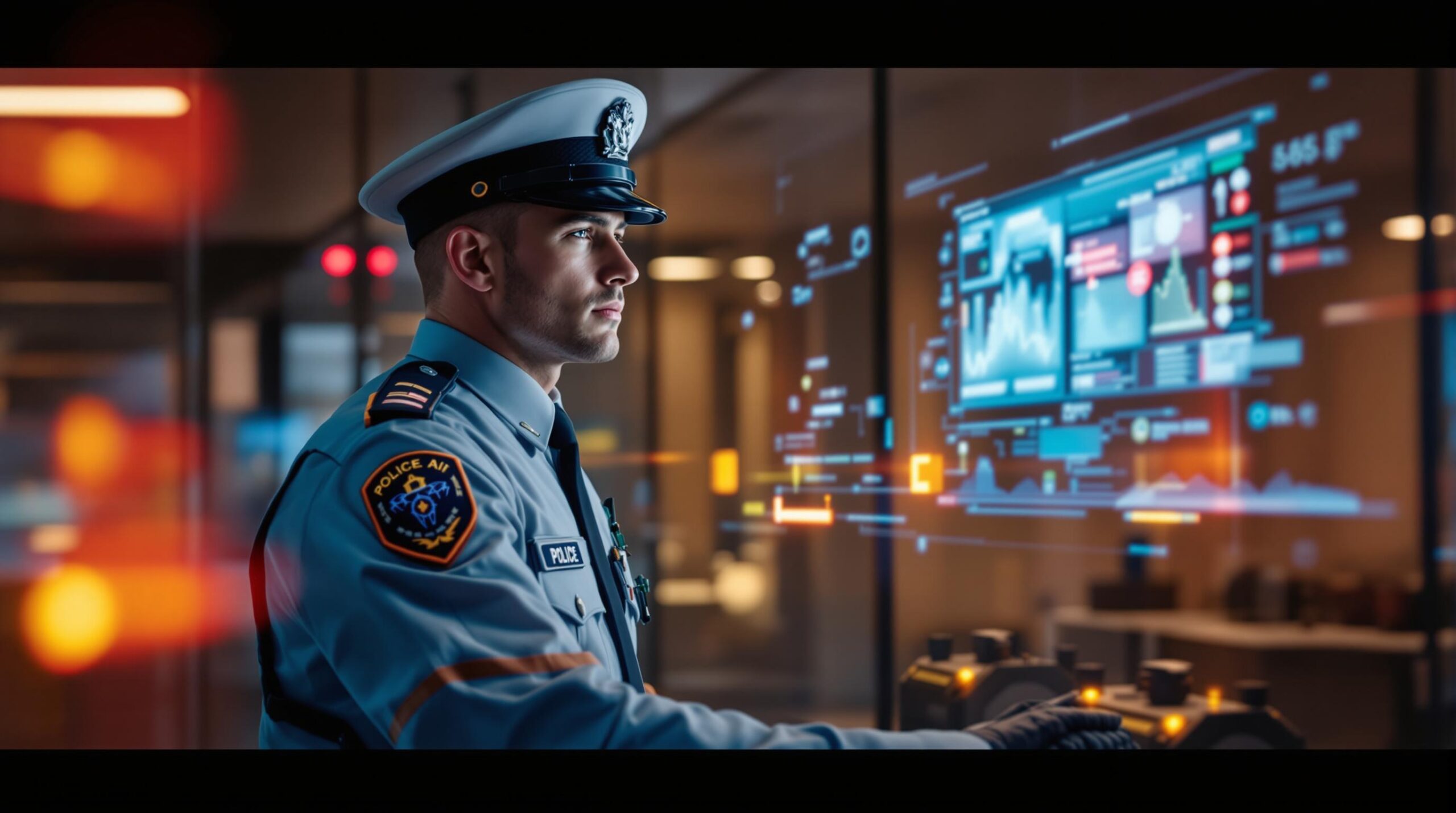Police officers face immense stress, which impacts their ability to recognize patterns and make critical decisions. High-pressure situations can cause tunnel vision, slower decision-making, and long-term mental health issues like PTSD and depression. Current training methods fail to prepare officers for these challenges, with 85% of first responders reporting mental health struggles and an average life expectancy of just 57 years.
Key Insights:
- Stress reduces situational awareness, distorts time perception, and weakens decision-making.
- Traditional training doesn’t replicate real-world stress or integrate stress resistance with pattern recognition.
- AI tools like SWORN.ai improve training by using biometric monitoring, real-time feedback, and tailored stress-resilience exercises.
Quick Overview of AI Benefits:
- Tracks stress levels and adjusts training in real time.
- Builds resilience through gradual stress exposure and recovery plans.
- Offers objective performance metrics like heart rate variability and decision speed.
AI-driven training bridges the gap, helping officers perform better under pressure while addressing their mental health needs.
How Stress Impacts Police Performance
Stress and Mental Processing
Stress can interfere with how officers process information. It narrows their focus, causes tunnel vision, and slows their ability to interpret events as they unfold. This makes it harder to recognize patterns and respond effectively in high-pressure situations.
Officer Stress Reactions
The body’s stress response can disrupt situational awareness. It dulls the ability to pick up on important cues, distorts time perception, and affects fine motor skills – making it easier to mishandle equipment or tools.
When these acute stress reactions occur repeatedly, they can lead to long-term issues, harming both cognitive abilities and overall well-being.
Long-Term Effects of Stress
Chronic stress adds another layer of risk. It weakens decision-making abilities, slows down pattern recognition, and increases personal risk in critical situations. Over time, this creates a cycle where stress not only worsens job performance but also takes a toll on health and mental clarity.
Next, we’ll explore why current training strategies fall short in addressing these stress-related challenges.
Current Training Method Shortfalls
Current training methods fall short in three key areas, particularly when it comes to preparing officers for real-world challenges.
Basic Training Limitations
Traditional training focuses on teaching pattern recognition in controlled environments. However, it doesn’t replicate the intense physical and mental stress officers face in the field. This gap is significant, especially considering that heart attack rates are five times higher for officers [1].
Stress Training Gaps
Existing programs often treat stress resistance and pattern recognition as separate skills, failing to address how they interact under high-pressure situations. This oversight has real consequences – 85% of first responders report mental health issues, with depression and PTSD rates also five times higher than average [1].
Training Methods Comparison
| Training Aspect | Traditional Methods | AI-Enhanced Methods |
|---|---|---|
| Stress Simulation | Limited to role-play scenarios | Real-time biometric monitoring with adaptive difficulty |
| Performance Tracking | Manual observation and subjective feedback | Data-driven analysis with objective metrics |
| Personalization | One-size-fits-all approach | Tailored training based on individual stress responses |
| Health Monitoring | Periodic health checks | Continuous monitoring with early intervention |
Next, we’ll explore AI-powered solutions for stress-ready pattern recognition.
sbb-itb-aa48905
AI Solutions for Stress-Ready Pattern Recognition
SWORN.ai’s AI modules bridge training gaps by combining biometric monitoring, scenario-based simulations, and resilience-focused coaching.
Biometric-Based Training
SWORN.ai uses biometric monitoring to track vital signs and stress levels, adjusting training difficulty in real time based on each officer’s responses. By identifying individual stress triggers, the system ensures challenges remain effective without overwhelming participants.
With these insights, SWORN.ai creates scenario drills that mimic real-world stressors.
High-Pressure Scenario Training
Using performance and workload data, the platform designs training drills that target specific areas for improvement. It adjusts scenario elements – like intensity, timing, complexity, and physical demands – based on real-time biometric feedback. This approach helps officers practice quick decision-making under pressure.
But it’s not just about tactics. The system also focuses on building mental resilience.
Mental Strength Building
With 85% of first responders reporting symptoms of mental health challenges [1], the platform prioritizes resilience through:
- Gradual exposure to stress with increasing intensity
- Immediate feedback on managing stress
- Customized cognitive recovery plans
Steps to Improve Training Results
Enhance training outcomes with AI-driven, biometric-based methods in three key areas: scenario design, progress tracking, and health support.
Scenario Training Methods
Leverage SWORN.ai to create scenarios that reflect CAD/RMS data, gradually increasing stress levels and adjusting dynamically based on officer responses. This focused exposure sharpens their ability to recognize patterns under pressure.
- Use wearables to establish a baseline for stress.
- Increase scenario complexity as performance improves.
- Adjust difficulty in real time using biometric feedback.
AI Progress Tracking
AI tools can offer detailed insights into officer performance and readiness. SWORN.ai’s analytics system combines multiple data sources to build detailed performance profiles.
Metrics to monitor include:
- Heart rate variability: A measure of stress and recovery.
- Decision speed under pressure: How quickly decisions are made in high-stakes situations.
- Pattern-recognition accuracy: The ability to spot critical details under stress.
- Recovery time: How quickly stress levels return to baseline.
Officer Health Support
Supporting officer health is just as important as measuring performance. SWORN.ai provides real-time stress monitoring and recovery tools to help officers stay ready for critical moments.
- Monitor stress levels during shifts in real time.
- Offer personalized recovery plans after high-stress events.
- Provide evidence-based wellness suggestions.
- Connect officers with peer and professional support resources.
This approach addresses the reality that 85% of first responders report symptoms of mental health conditions [1], ensuring they remain prepared for high-pressure tasks like pattern recognition.
Conclusion: AI’s Role in Police Training
AI-powered training tools are helping officers improve how they recognize patterns under pressure while also focusing on their overall health. By integrating biometric-based scenario designs and tracking progress, these tools provide a comprehensive approach to training.
The SWORN.ai platform fine-tunes training intensity using real-time biometric data, offers tailored resilience strategies, and applies proven wellness practices.
Police officers face serious challenges: an average life expectancy of just 57 years and a heart attack risk five times higher than the general population. These statistics highlight the urgent need for solutions that prioritize both performance and health.
With increasing resignations and mounting demands, AI-based platforms offer dynamic training environments that enhance decision-making in high-stress situations and promote resilience. This approach addresses the unique pressures of modern law enforcement while supporting long-term well-being.






